IKEA's Sustainable Practices: Innovation and Organizational Strategies
VerifiedAdded on 2020/12/29
|15
|3649
|274
Report
AI Summary
This report examines IKEA's sustainability efforts, focusing on its innovative approaches to environmental responsibility and business development. It begins with a reflection on the importance of sustainability and the role of organizations in addressing global challenges. The report then delves into IKEA's specific sustainability offerings, including its use of renewable energy, electric vehicles, and sustainable sourcing practices. It explores the company's stakeholder engagement, benchmarks, and key performance indicators, highlighting its commitment to clean water, affordable energy, and reducing inequalities. The report also analyzes relevant literature and provides recommendations for managers, concluding with an assessment of IKEA's overall sustainability strategies and their impact on the retail sector. The report emphasizes the importance of innovation and sustainable practices for long-term business success and environmental protection.
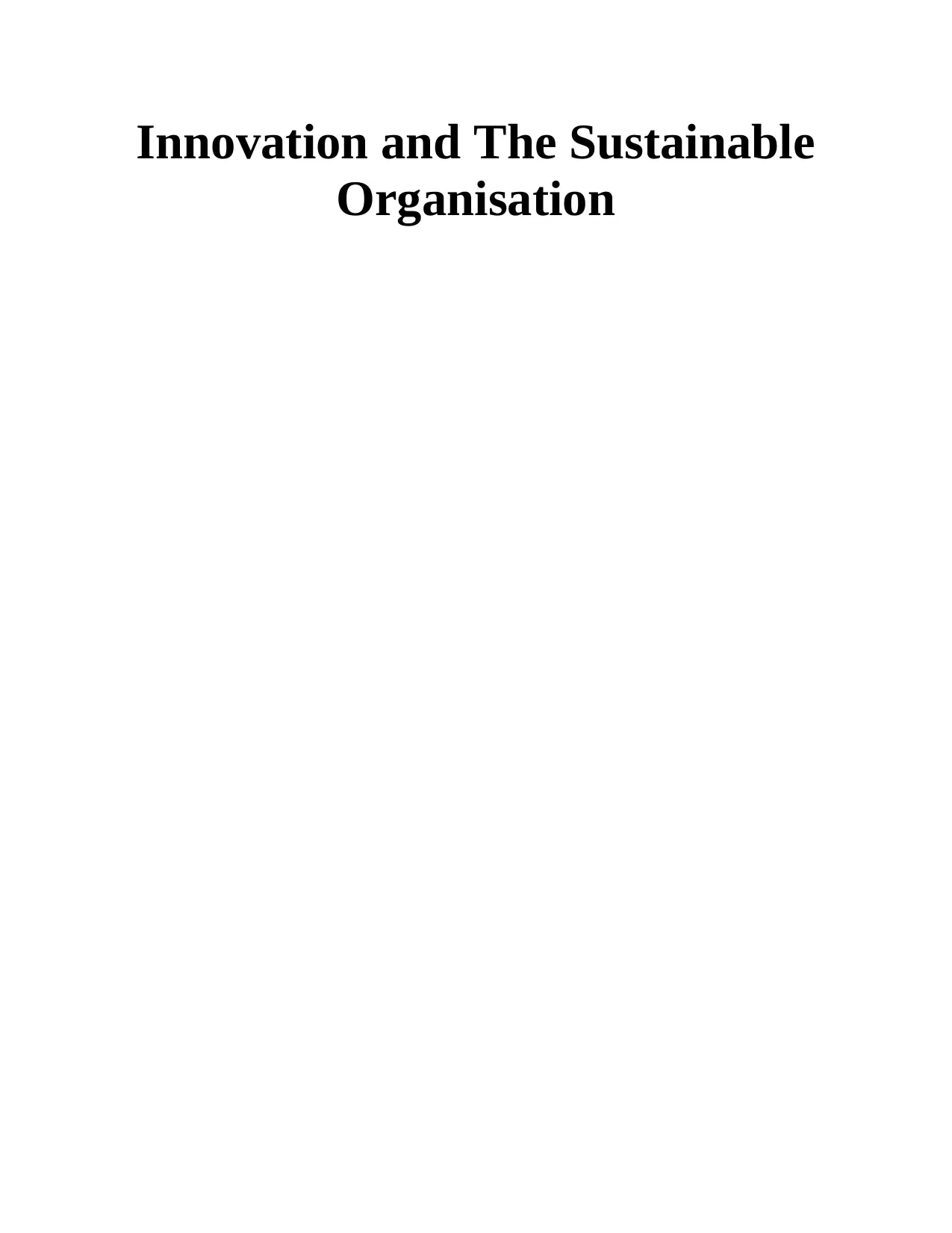
Innovation and The Sustainable
Organisation
Organisation
Paraphrase This Document
Need a fresh take? Get an instant paraphrase of this document with our AI Paraphraser
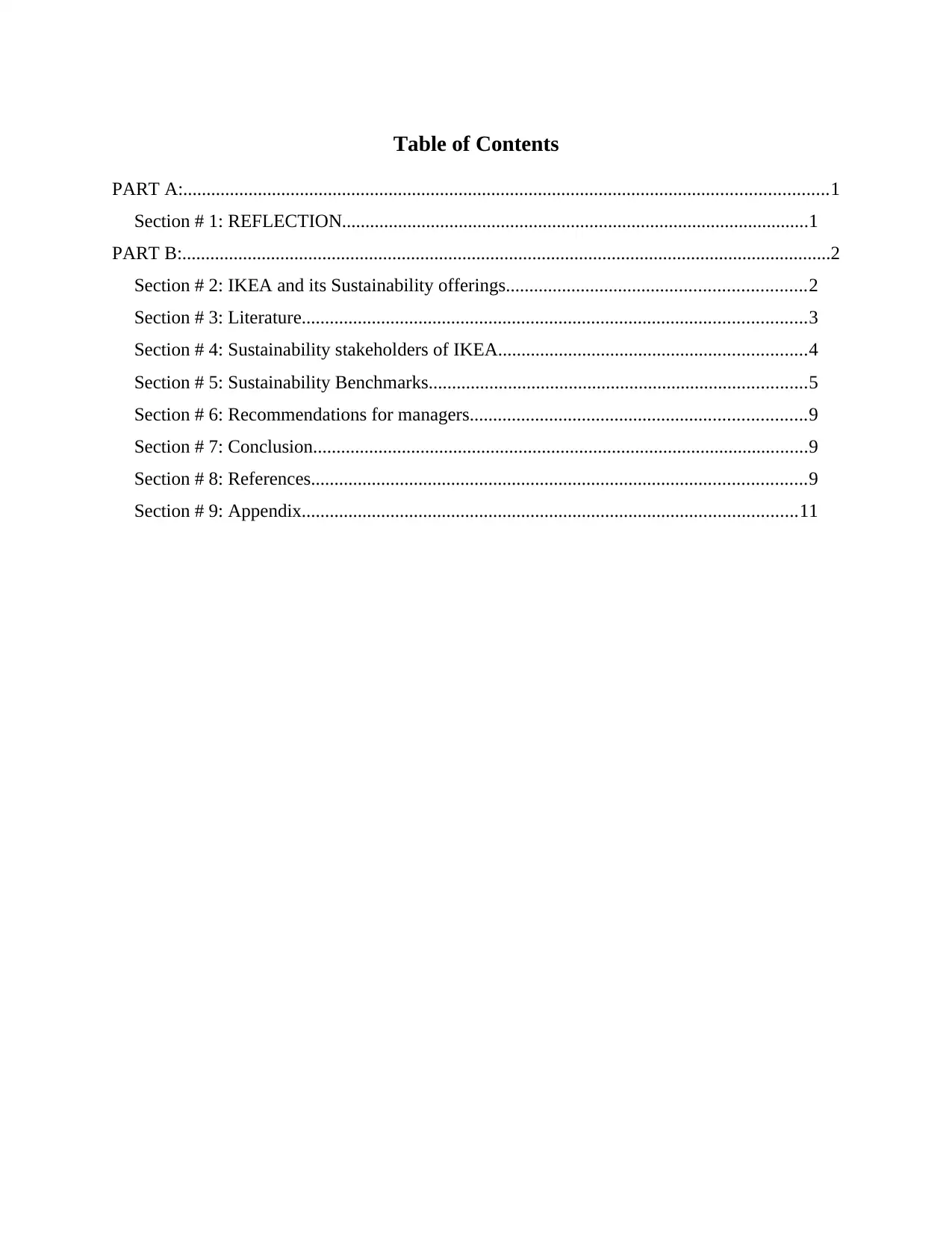
Table of Contents
PART A:..........................................................................................................................................1
Section # 1: REFLECTION....................................................................................................1
PART B:...........................................................................................................................................2
Section # 2: IKEA and its Sustainability offerings................................................................2
Section # 3: Literature............................................................................................................3
Section # 4: Sustainability stakeholders of IKEA..................................................................4
Section # 5: Sustainability Benchmarks.................................................................................5
Section # 6: Recommendations for managers........................................................................9
Section # 7: Conclusion..........................................................................................................9
Section # 8: References..........................................................................................................9
Section # 9: Appendix..........................................................................................................11
PART A:..........................................................................................................................................1
Section # 1: REFLECTION....................................................................................................1
PART B:...........................................................................................................................................2
Section # 2: IKEA and its Sustainability offerings................................................................2
Section # 3: Literature............................................................................................................3
Section # 4: Sustainability stakeholders of IKEA..................................................................4
Section # 5: Sustainability Benchmarks.................................................................................5
Section # 6: Recommendations for managers........................................................................9
Section # 7: Conclusion..........................................................................................................9
Section # 8: References..........................................................................................................9
Section # 9: Appendix..........................................................................................................11

⊘ This is a preview!⊘
Do you want full access?
Subscribe today to unlock all pages.

Trusted by 1+ million students worldwide
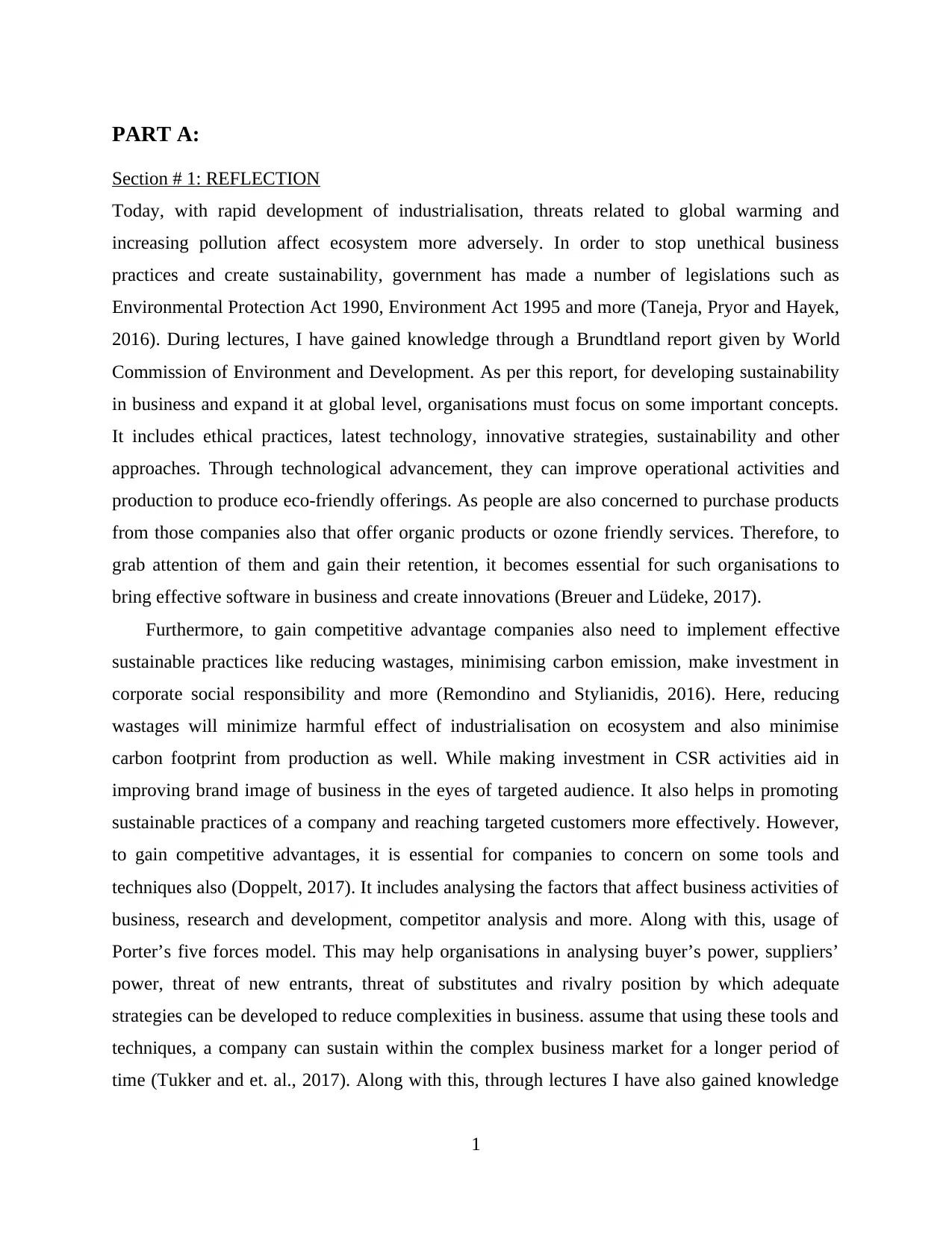
PART A:
Section # 1: REFLECTION
Today, with rapid development of industrialisation, threats related to global warming and
increasing pollution affect ecosystem more adversely. In order to stop unethical business
practices and create sustainability, government has made a number of legislations such as
Environmental Protection Act 1990, Environment Act 1995 and more (Taneja, Pryor and Hayek,
2016). During lectures, I have gained knowledge through a Brundtland report given by World
Commission of Environment and Development. As per this report, for developing sustainability
in business and expand it at global level, organisations must focus on some important concepts.
It includes ethical practices, latest technology, innovative strategies, sustainability and other
approaches. Through technological advancement, they can improve operational activities and
production to produce eco-friendly offerings. As people are also concerned to purchase products
from those companies also that offer organic products or ozone friendly services. Therefore, to
grab attention of them and gain their retention, it becomes essential for such organisations to
bring effective software in business and create innovations (Breuer and Lüdeke, 2017).
Furthermore, to gain competitive advantage companies also need to implement effective
sustainable practices like reducing wastages, minimising carbon emission, make investment in
corporate social responsibility and more (Remondino and Stylianidis, 2016). Here, reducing
wastages will minimize harmful effect of industrialisation on ecosystem and also minimise
carbon footprint from production as well. While making investment in CSR activities aid in
improving brand image of business in the eyes of targeted audience. It also helps in promoting
sustainable practices of a company and reaching targeted customers more effectively. However,
to gain competitive advantages, it is essential for companies to concern on some tools and
techniques also (Doppelt, 2017). It includes analysing the factors that affect business activities of
business, research and development, competitor analysis and more. Along with this, usage of
Porter’s five forces model. This may help organisations in analysing buyer’s power, suppliers’
power, threat of new entrants, threat of substitutes and rivalry position by which adequate
strategies can be developed to reduce complexities in business. assume that using these tools and
techniques, a company can sustain within the complex business market for a longer period of
time (Tukker and et. al., 2017). Along with this, through lectures I have also gained knowledge
1
Section # 1: REFLECTION
Today, with rapid development of industrialisation, threats related to global warming and
increasing pollution affect ecosystem more adversely. In order to stop unethical business
practices and create sustainability, government has made a number of legislations such as
Environmental Protection Act 1990, Environment Act 1995 and more (Taneja, Pryor and Hayek,
2016). During lectures, I have gained knowledge through a Brundtland report given by World
Commission of Environment and Development. As per this report, for developing sustainability
in business and expand it at global level, organisations must focus on some important concepts.
It includes ethical practices, latest technology, innovative strategies, sustainability and other
approaches. Through technological advancement, they can improve operational activities and
production to produce eco-friendly offerings. As people are also concerned to purchase products
from those companies also that offer organic products or ozone friendly services. Therefore, to
grab attention of them and gain their retention, it becomes essential for such organisations to
bring effective software in business and create innovations (Breuer and Lüdeke, 2017).
Furthermore, to gain competitive advantage companies also need to implement effective
sustainable practices like reducing wastages, minimising carbon emission, make investment in
corporate social responsibility and more (Remondino and Stylianidis, 2016). Here, reducing
wastages will minimize harmful effect of industrialisation on ecosystem and also minimise
carbon footprint from production as well. While making investment in CSR activities aid in
improving brand image of business in the eyes of targeted audience. It also helps in promoting
sustainable practices of a company and reaching targeted customers more effectively. However,
to gain competitive advantages, it is essential for companies to concern on some tools and
techniques also (Doppelt, 2017). It includes analysing the factors that affect business activities of
business, research and development, competitor analysis and more. Along with this, usage of
Porter’s five forces model. This may help organisations in analysing buyer’s power, suppliers’
power, threat of new entrants, threat of substitutes and rivalry position by which adequate
strategies can be developed to reduce complexities in business. assume that using these tools and
techniques, a company can sustain within the complex business market for a longer period of
time (Tukker and et. al., 2017). Along with this, through lectures I have also gained knowledge
1
Paraphrase This Document
Need a fresh take? Get an instant paraphrase of this document with our AI Paraphraser
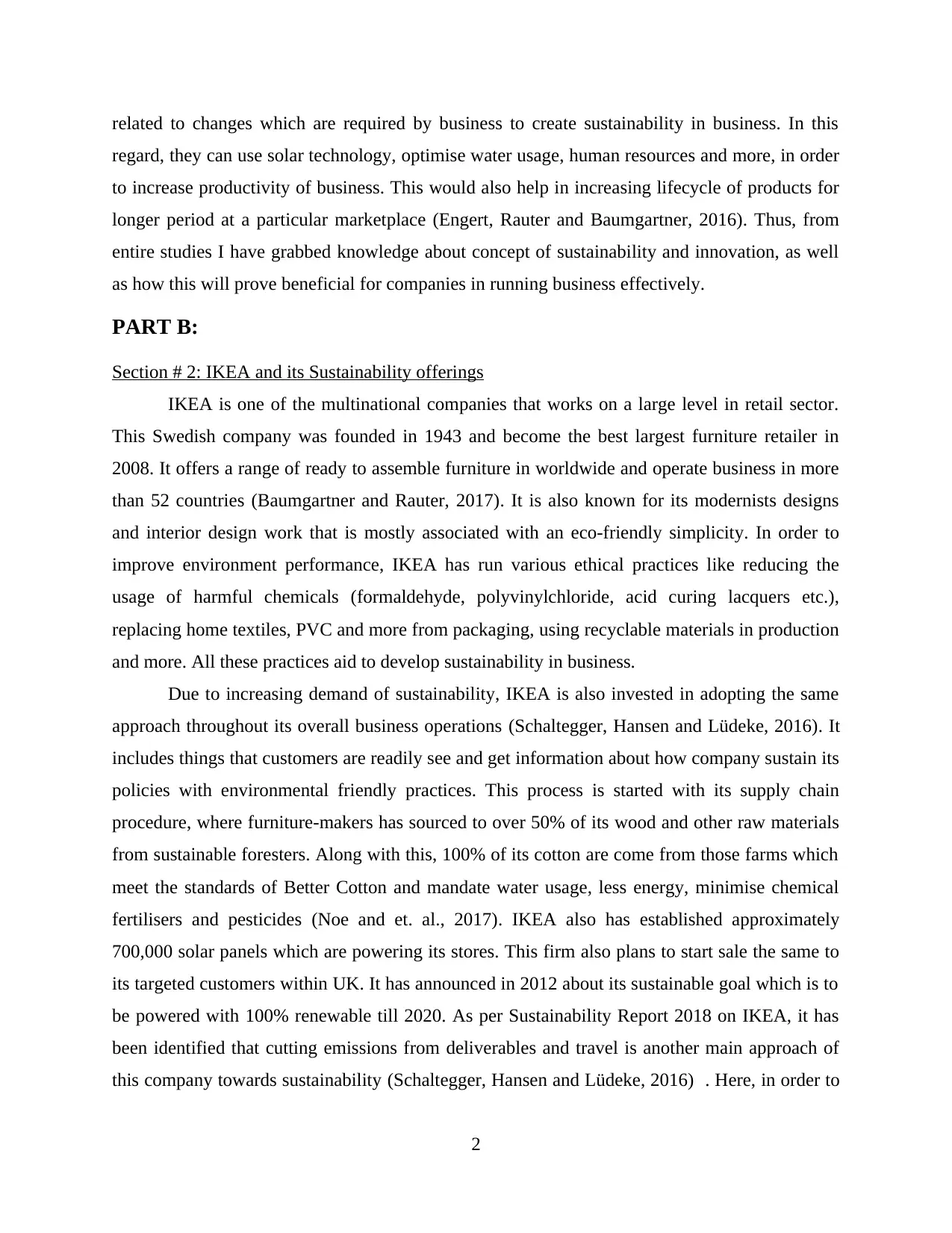
related to changes which are required by business to create sustainability in business. In this
regard, they can use solar technology, optimise water usage, human resources and more, in order
to increase productivity of business. This would also help in increasing lifecycle of products for
longer period at a particular marketplace (Engert, Rauter and Baumgartner, 2016). Thus, from
entire studies I have grabbed knowledge about concept of sustainability and innovation, as well
as how this will prove beneficial for companies in running business effectively.
PART B:
Section # 2: IKEA and its Sustainability offerings
IKEA is one of the multinational companies that works on a large level in retail sector.
This Swedish company was founded in 1943 and become the best largest furniture retailer in
2008. It offers a range of ready to assemble furniture in worldwide and operate business in more
than 52 countries (Baumgartner and Rauter, 2017). It is also known for its modernists designs
and interior design work that is mostly associated with an eco-friendly simplicity. In order to
improve environment performance, IKEA has run various ethical practices like reducing the
usage of harmful chemicals (formaldehyde, polyvinylchloride, acid curing lacquers etc.),
replacing home textiles, PVC and more from packaging, using recyclable materials in production
and more. All these practices aid to develop sustainability in business.
Due to increasing demand of sustainability, IKEA is also invested in adopting the same
approach throughout its overall business operations (Schaltegger, Hansen and Lüdeke, 2016). It
includes things that customers are readily see and get information about how company sustain its
policies with environmental friendly practices. This process is started with its supply chain
procedure, where furniture-makers has sourced to over 50% of its wood and other raw materials
from sustainable foresters. Along with this, 100% of its cotton are come from those farms which
meet the standards of Better Cotton and mandate water usage, less energy, minimise chemical
fertilisers and pesticides (Noe and et. al., 2017). IKEA also has established approximately
700,000 solar panels which are powering its stores. This firm also plans to start sale the same to
its targeted customers within UK. It has announced in 2012 about its sustainable goal which is to
be powered with 100% renewable till 2020. As per Sustainability Report 2018 on IKEA, it has
been identified that cutting emissions from deliverables and travel is another main approach of
this company towards sustainability (Schaltegger, Hansen and Lüdeke, 2016) . Here, in order to
2
regard, they can use solar technology, optimise water usage, human resources and more, in order
to increase productivity of business. This would also help in increasing lifecycle of products for
longer period at a particular marketplace (Engert, Rauter and Baumgartner, 2016). Thus, from
entire studies I have grabbed knowledge about concept of sustainability and innovation, as well
as how this will prove beneficial for companies in running business effectively.
PART B:
Section # 2: IKEA and its Sustainability offerings
IKEA is one of the multinational companies that works on a large level in retail sector.
This Swedish company was founded in 1943 and become the best largest furniture retailer in
2008. It offers a range of ready to assemble furniture in worldwide and operate business in more
than 52 countries (Baumgartner and Rauter, 2017). It is also known for its modernists designs
and interior design work that is mostly associated with an eco-friendly simplicity. In order to
improve environment performance, IKEA has run various ethical practices like reducing the
usage of harmful chemicals (formaldehyde, polyvinylchloride, acid curing lacquers etc.),
replacing home textiles, PVC and more from packaging, using recyclable materials in production
and more. All these practices aid to develop sustainability in business.
Due to increasing demand of sustainability, IKEA is also invested in adopting the same
approach throughout its overall business operations (Schaltegger, Hansen and Lüdeke, 2016). It
includes things that customers are readily see and get information about how company sustain its
policies with environmental friendly practices. This process is started with its supply chain
procedure, where furniture-makers has sourced to over 50% of its wood and other raw materials
from sustainable foresters. Along with this, 100% of its cotton are come from those farms which
meet the standards of Better Cotton and mandate water usage, less energy, minimise chemical
fertilisers and pesticides (Noe and et. al., 2017). IKEA also has established approximately
700,000 solar panels which are powering its stores. This firm also plans to start sale the same to
its targeted customers within UK. It has announced in 2012 about its sustainable goal which is to
be powered with 100% renewable till 2020. As per Sustainability Report 2018 on IKEA, it has
been identified that cutting emissions from deliverables and travel is another main approach of
this company towards sustainability (Schaltegger, Hansen and Lüdeke, 2016) . Here, in order to
2
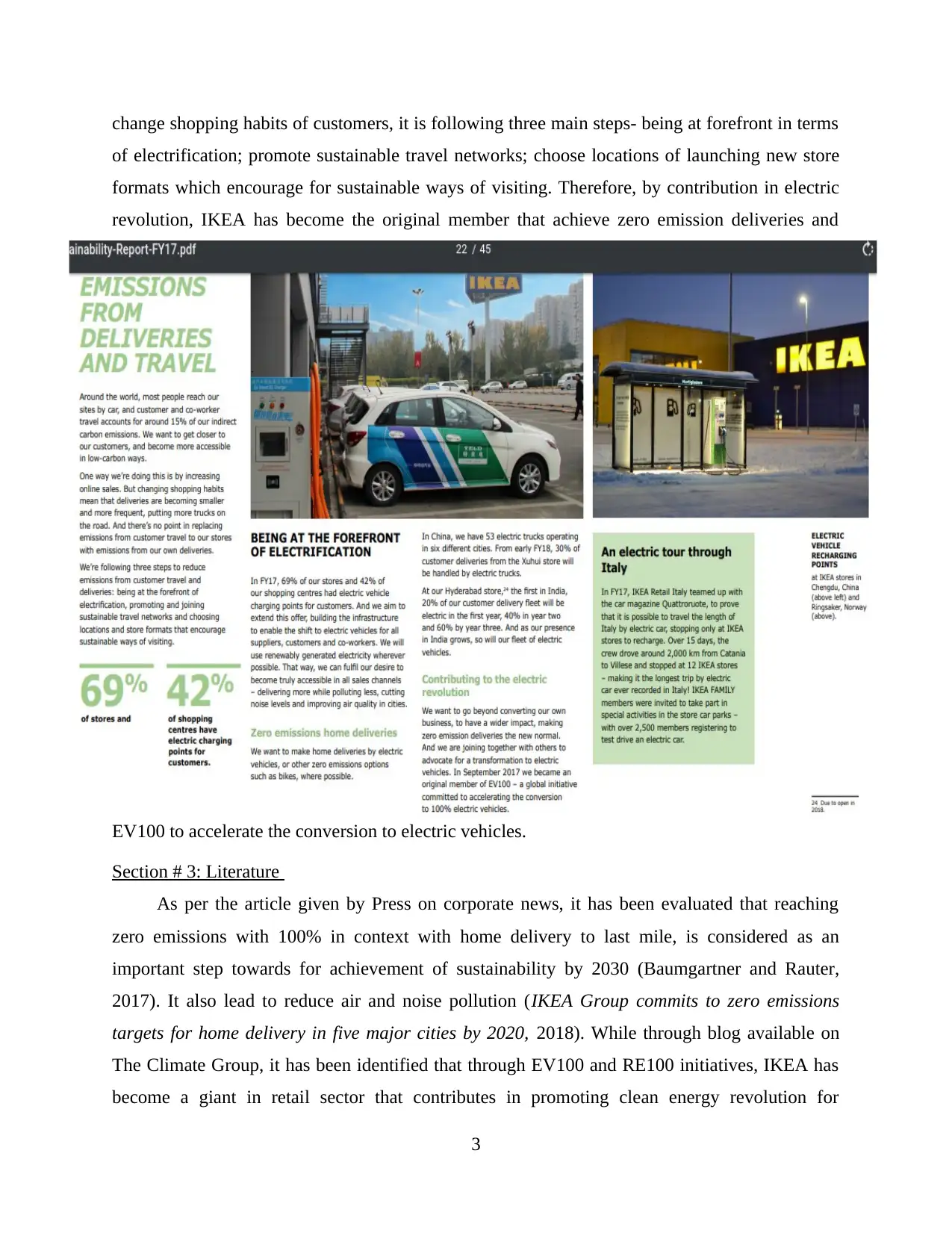
change shopping habits of customers, it is following three main steps- being at forefront in terms
of electrification; promote sustainable travel networks; choose locations of launching new store
formats which encourage for sustainable ways of visiting. Therefore, by contribution in electric
revolution, IKEA has become the original member that achieve zero emission deliveries and
EV100 to accelerate the conversion to electric vehicles.
Section # 3: Literature
As per the article given by Press on corporate news, it has been evaluated that reaching
zero emissions with 100% in context with home delivery to last mile, is considered as an
important step towards for achievement of sustainability by 2030 (Baumgartner and Rauter,
2017). It also lead to reduce air and noise pollution (IKEA Group commits to zero emissions
targets for home delivery in five major cities by 2020, 2018). While through blog available on
The Climate Group, it has been identified that through EV100 and RE100 initiatives, IKEA has
become a giant in retail sector that contributes in promoting clean energy revolution for
3
of electrification; promote sustainable travel networks; choose locations of launching new store
formats which encourage for sustainable ways of visiting. Therefore, by contribution in electric
revolution, IKEA has become the original member that achieve zero emission deliveries and
EV100 to accelerate the conversion to electric vehicles.
Section # 3: Literature
As per the article given by Press on corporate news, it has been evaluated that reaching
zero emissions with 100% in context with home delivery to last mile, is considered as an
important step towards for achievement of sustainability by 2030 (Baumgartner and Rauter,
2017). It also lead to reduce air and noise pollution (IKEA Group commits to zero emissions
targets for home delivery in five major cities by 2020, 2018). While through blog available on
The Climate Group, it has been identified that through EV100 and RE100 initiatives, IKEA has
become a giant in retail sector that contributes in promoting clean energy revolution for
3
⊘ This is a preview!⊘
Do you want full access?
Subscribe today to unlock all pages.

Trusted by 1+ million students worldwide
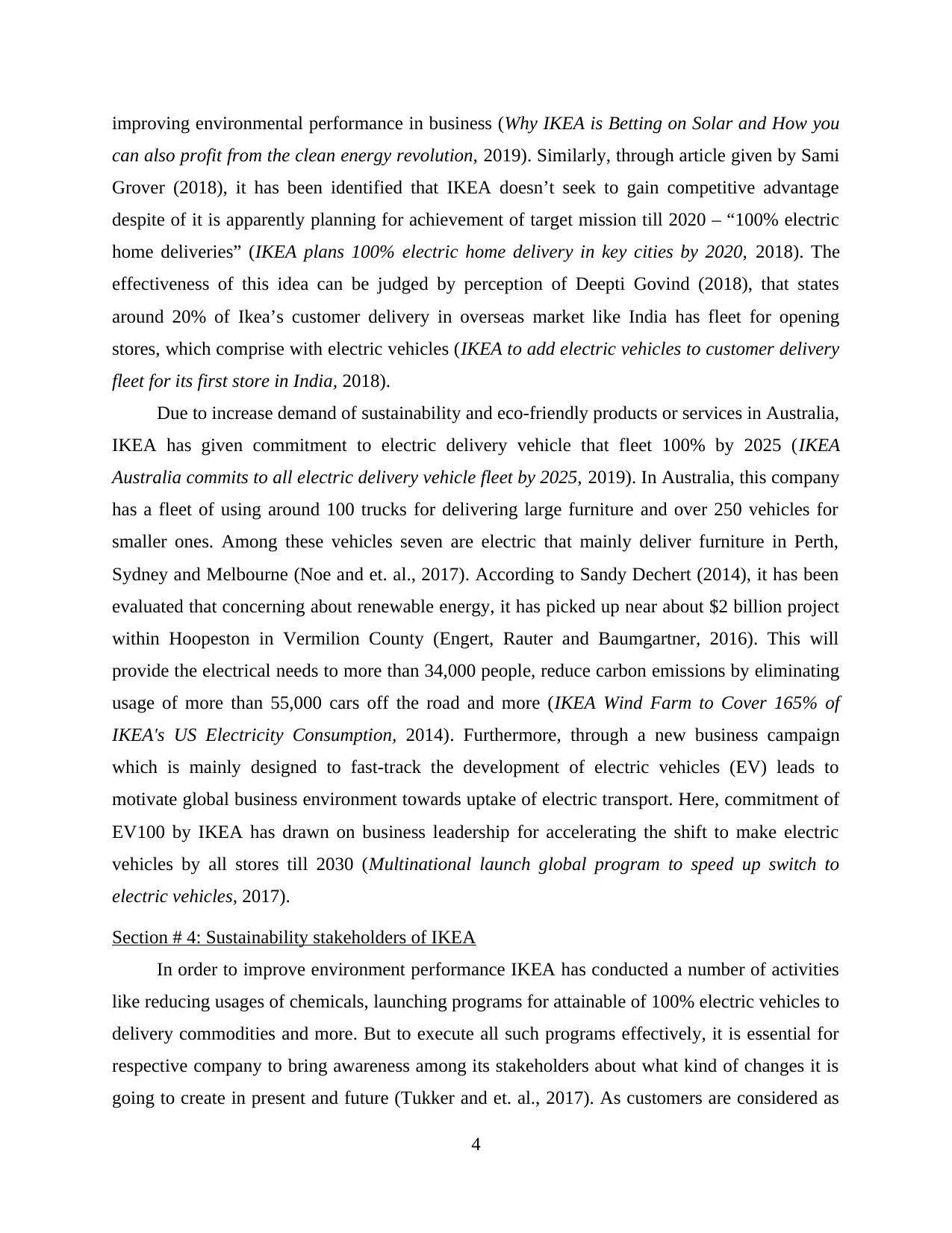
improving environmental performance in business (Why IKEA is Betting on Solar and How you
can also profit from the clean energy revolution, 2019). Similarly, through article given by Sami
Grover (2018), it has been identified that IKEA doesn’t seek to gain competitive advantage
despite of it is apparently planning for achievement of target mission till 2020 – “100% electric
home deliveries” (IKEA plans 100% electric home delivery in key cities by 2020, 2018). The
effectiveness of this idea can be judged by perception of Deepti Govind (2018), that states
around 20% of Ikea’s customer delivery in overseas market like India has fleet for opening
stores, which comprise with electric vehicles (IKEA to add electric vehicles to customer delivery
fleet for its first store in India, 2018).
Due to increase demand of sustainability and eco-friendly products or services in Australia,
IKEA has given commitment to electric delivery vehicle that fleet 100% by 2025 (IKEA
Australia commits to all electric delivery vehicle fleet by 2025, 2019). In Australia, this company
has a fleet of using around 100 trucks for delivering large furniture and over 250 vehicles for
smaller ones. Among these vehicles seven are electric that mainly deliver furniture in Perth,
Sydney and Melbourne (Noe and et. al., 2017). According to Sandy Dechert (2014), it has been
evaluated that concerning about renewable energy, it has picked up near about $2 billion project
within Hoopeston in Vermilion County (Engert, Rauter and Baumgartner, 2016). This will
provide the electrical needs to more than 34,000 people, reduce carbon emissions by eliminating
usage of more than 55,000 cars off the road and more (IKEA Wind Farm to Cover 165% of
IKEA's US Electricity Consumption, 2014). Furthermore, through a new business campaign
which is mainly designed to fast-track the development of electric vehicles (EV) leads to
motivate global business environment towards uptake of electric transport. Here, commitment of
EV100 by IKEA has drawn on business leadership for accelerating the shift to make electric
vehicles by all stores till 2030 (Multinational launch global program to speed up switch to
electric vehicles, 2017).
Section # 4: Sustainability stakeholders of IKEA
In order to improve environment performance IKEA has conducted a number of activities
like reducing usages of chemicals, launching programs for attainable of 100% electric vehicles to
delivery commodities and more. But to execute all such programs effectively, it is essential for
respective company to bring awareness among its stakeholders about what kind of changes it is
going to create in present and future (Tukker and et. al., 2017). As customers are considered as
4
can also profit from the clean energy revolution, 2019). Similarly, through article given by Sami
Grover (2018), it has been identified that IKEA doesn’t seek to gain competitive advantage
despite of it is apparently planning for achievement of target mission till 2020 – “100% electric
home deliveries” (IKEA plans 100% electric home delivery in key cities by 2020, 2018). The
effectiveness of this idea can be judged by perception of Deepti Govind (2018), that states
around 20% of Ikea’s customer delivery in overseas market like India has fleet for opening
stores, which comprise with electric vehicles (IKEA to add electric vehicles to customer delivery
fleet for its first store in India, 2018).
Due to increase demand of sustainability and eco-friendly products or services in Australia,
IKEA has given commitment to electric delivery vehicle that fleet 100% by 2025 (IKEA
Australia commits to all electric delivery vehicle fleet by 2025, 2019). In Australia, this company
has a fleet of using around 100 trucks for delivering large furniture and over 250 vehicles for
smaller ones. Among these vehicles seven are electric that mainly deliver furniture in Perth,
Sydney and Melbourne (Noe and et. al., 2017). According to Sandy Dechert (2014), it has been
evaluated that concerning about renewable energy, it has picked up near about $2 billion project
within Hoopeston in Vermilion County (Engert, Rauter and Baumgartner, 2016). This will
provide the electrical needs to more than 34,000 people, reduce carbon emissions by eliminating
usage of more than 55,000 cars off the road and more (IKEA Wind Farm to Cover 165% of
IKEA's US Electricity Consumption, 2014). Furthermore, through a new business campaign
which is mainly designed to fast-track the development of electric vehicles (EV) leads to
motivate global business environment towards uptake of electric transport. Here, commitment of
EV100 by IKEA has drawn on business leadership for accelerating the shift to make electric
vehicles by all stores till 2030 (Multinational launch global program to speed up switch to
electric vehicles, 2017).
Section # 4: Sustainability stakeholders of IKEA
In order to improve environment performance IKEA has conducted a number of activities
like reducing usages of chemicals, launching programs for attainable of 100% electric vehicles to
delivery commodities and more. But to execute all such programs effectively, it is essential for
respective company to bring awareness among its stakeholders about what kind of changes it is
going to create in present and future (Tukker and et. al., 2017). As customers are considered as
4
Paraphrase This Document
Need a fresh take? Get an instant paraphrase of this document with our AI Paraphraser
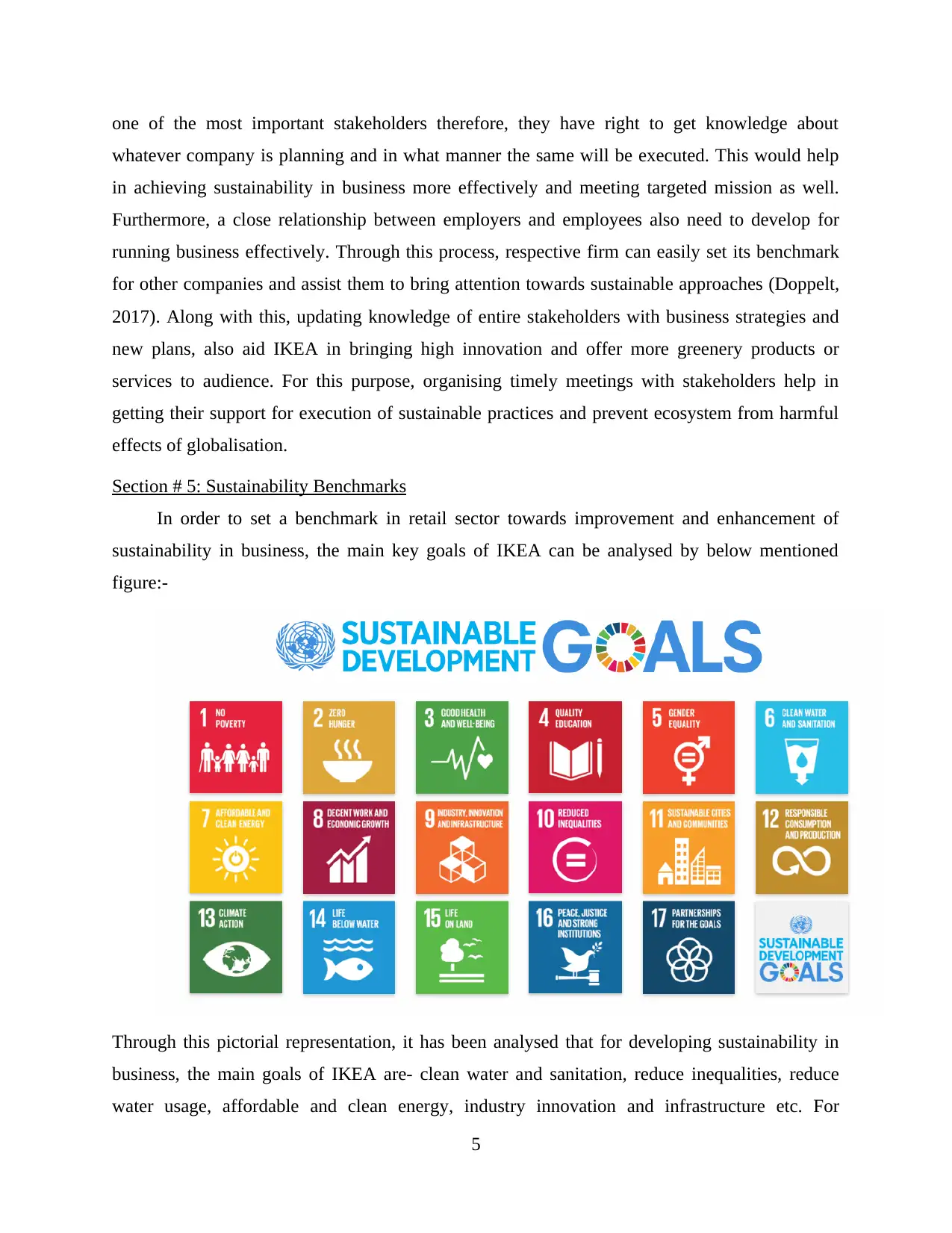
one of the most important stakeholders therefore, they have right to get knowledge about
whatever company is planning and in what manner the same will be executed. This would help
in achieving sustainability in business more effectively and meeting targeted mission as well.
Furthermore, a close relationship between employers and employees also need to develop for
running business effectively. Through this process, respective firm can easily set its benchmark
for other companies and assist them to bring attention towards sustainable approaches (Doppelt,
2017). Along with this, updating knowledge of entire stakeholders with business strategies and
new plans, also aid IKEA in bringing high innovation and offer more greenery products or
services to audience. For this purpose, organising timely meetings with stakeholders help in
getting their support for execution of sustainable practices and prevent ecosystem from harmful
effects of globalisation.
Section # 5: Sustainability Benchmarks
In order to set a benchmark in retail sector towards improvement and enhancement of
sustainability in business, the main key goals of IKEA can be analysed by below mentioned
figure:-
Through this pictorial representation, it has been analysed that for developing sustainability in
business, the main goals of IKEA are- clean water and sanitation, reduce inequalities, reduce
water usage, affordable and clean energy, industry innovation and infrastructure etc. For
5
whatever company is planning and in what manner the same will be executed. This would help
in achieving sustainability in business more effectively and meeting targeted mission as well.
Furthermore, a close relationship between employers and employees also need to develop for
running business effectively. Through this process, respective firm can easily set its benchmark
for other companies and assist them to bring attention towards sustainable approaches (Doppelt,
2017). Along with this, updating knowledge of entire stakeholders with business strategies and
new plans, also aid IKEA in bringing high innovation and offer more greenery products or
services to audience. For this purpose, organising timely meetings with stakeholders help in
getting their support for execution of sustainable practices and prevent ecosystem from harmful
effects of globalisation.
Section # 5: Sustainability Benchmarks
In order to set a benchmark in retail sector towards improvement and enhancement of
sustainability in business, the main key goals of IKEA can be analysed by below mentioned
figure:-
Through this pictorial representation, it has been analysed that for developing sustainability in
business, the main goals of IKEA are- clean water and sanitation, reduce inequalities, reduce
water usage, affordable and clean energy, industry innovation and infrastructure etc. For
5
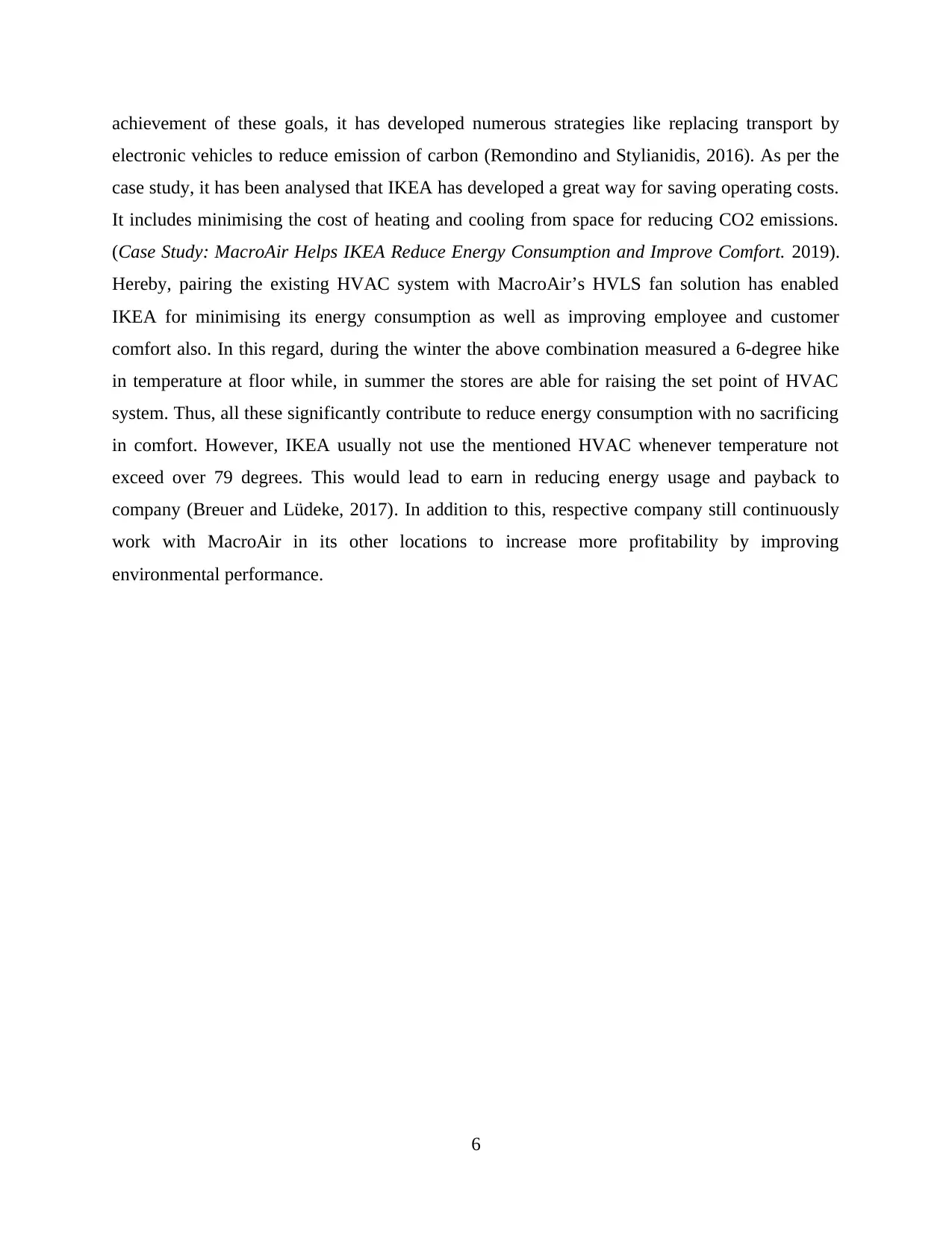
achievement of these goals, it has developed numerous strategies like replacing transport by
electronic vehicles to reduce emission of carbon (Remondino and Stylianidis, 2016). As per the
case study, it has been analysed that IKEA has developed a great way for saving operating costs.
It includes minimising the cost of heating and cooling from space for reducing CO2 emissions.
(Case Study: MacroAir Helps IKEA Reduce Energy Consumption and Improve Comfort. 2019).
Hereby, pairing the existing HVAC system with MacroAir’s HVLS fan solution has enabled
IKEA for minimising its energy consumption as well as improving employee and customer
comfort also. In this regard, during the winter the above combination measured a 6-degree hike
in temperature at floor while, in summer the stores are able for raising the set point of HVAC
system. Thus, all these significantly contribute to reduce energy consumption with no sacrificing
in comfort. However, IKEA usually not use the mentioned HVAC whenever temperature not
exceed over 79 degrees. This would lead to earn in reducing energy usage and payback to
company (Breuer and Lüdeke, 2017). In addition to this, respective company still continuously
work with MacroAir in its other locations to increase more profitability by improving
environmental performance.
6
electronic vehicles to reduce emission of carbon (Remondino and Stylianidis, 2016). As per the
case study, it has been analysed that IKEA has developed a great way for saving operating costs.
It includes minimising the cost of heating and cooling from space for reducing CO2 emissions.
(Case Study: MacroAir Helps IKEA Reduce Energy Consumption and Improve Comfort. 2019).
Hereby, pairing the existing HVAC system with MacroAir’s HVLS fan solution has enabled
IKEA for minimising its energy consumption as well as improving employee and customer
comfort also. In this regard, during the winter the above combination measured a 6-degree hike
in temperature at floor while, in summer the stores are able for raising the set point of HVAC
system. Thus, all these significantly contribute to reduce energy consumption with no sacrificing
in comfort. However, IKEA usually not use the mentioned HVAC whenever temperature not
exceed over 79 degrees. This would lead to earn in reducing energy usage and payback to
company (Breuer and Lüdeke, 2017). In addition to this, respective company still continuously
work with MacroAir in its other locations to increase more profitability by improving
environmental performance.
6
⊘ This is a preview!⊘
Do you want full access?
Subscribe today to unlock all pages.

Trusted by 1+ million students worldwide
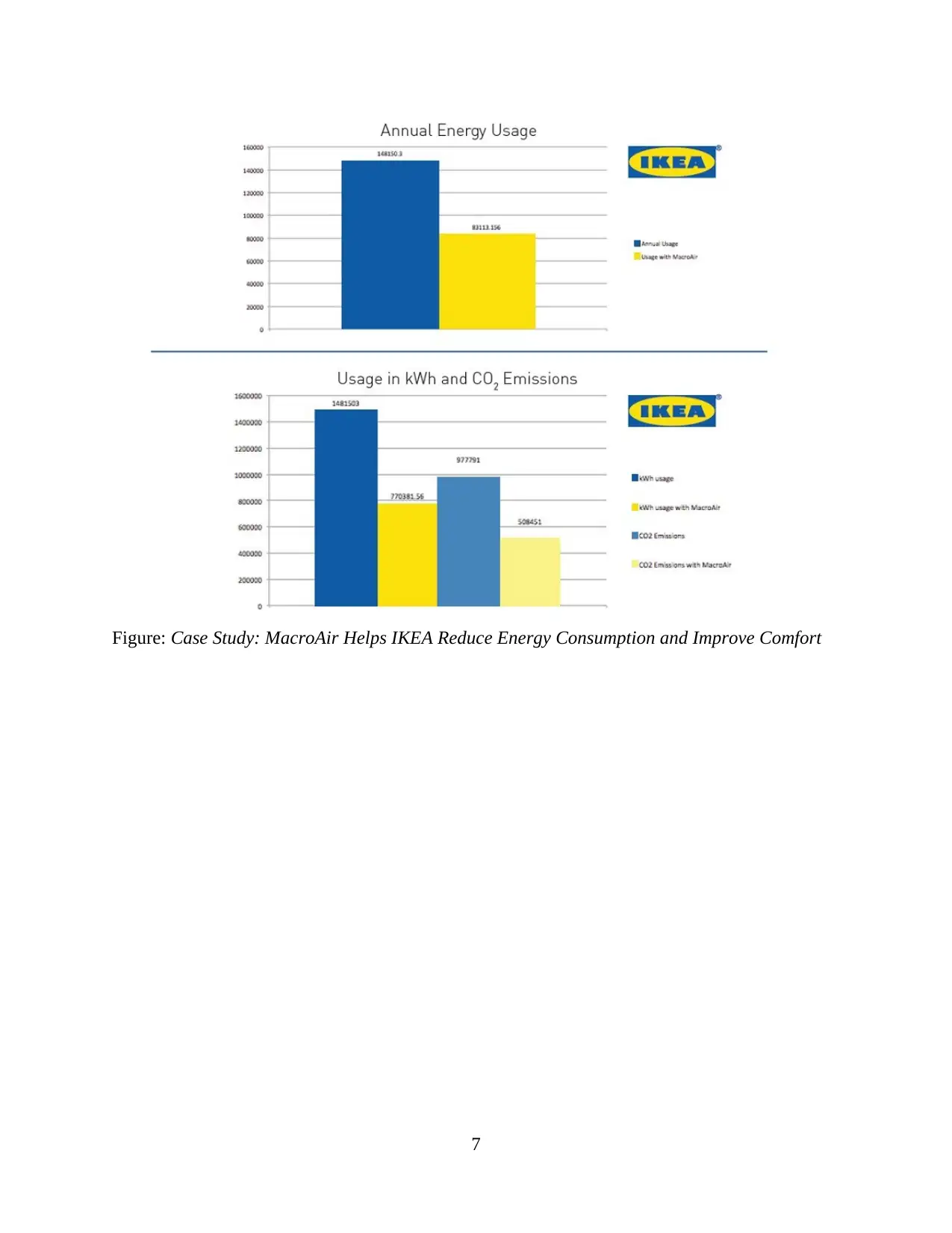
Figure: Case Study: MacroAir Helps IKEA Reduce Energy Consumption and Improve Comfort
7
7
Paraphrase This Document
Need a fresh take? Get an instant paraphrase of this document with our AI Paraphraser
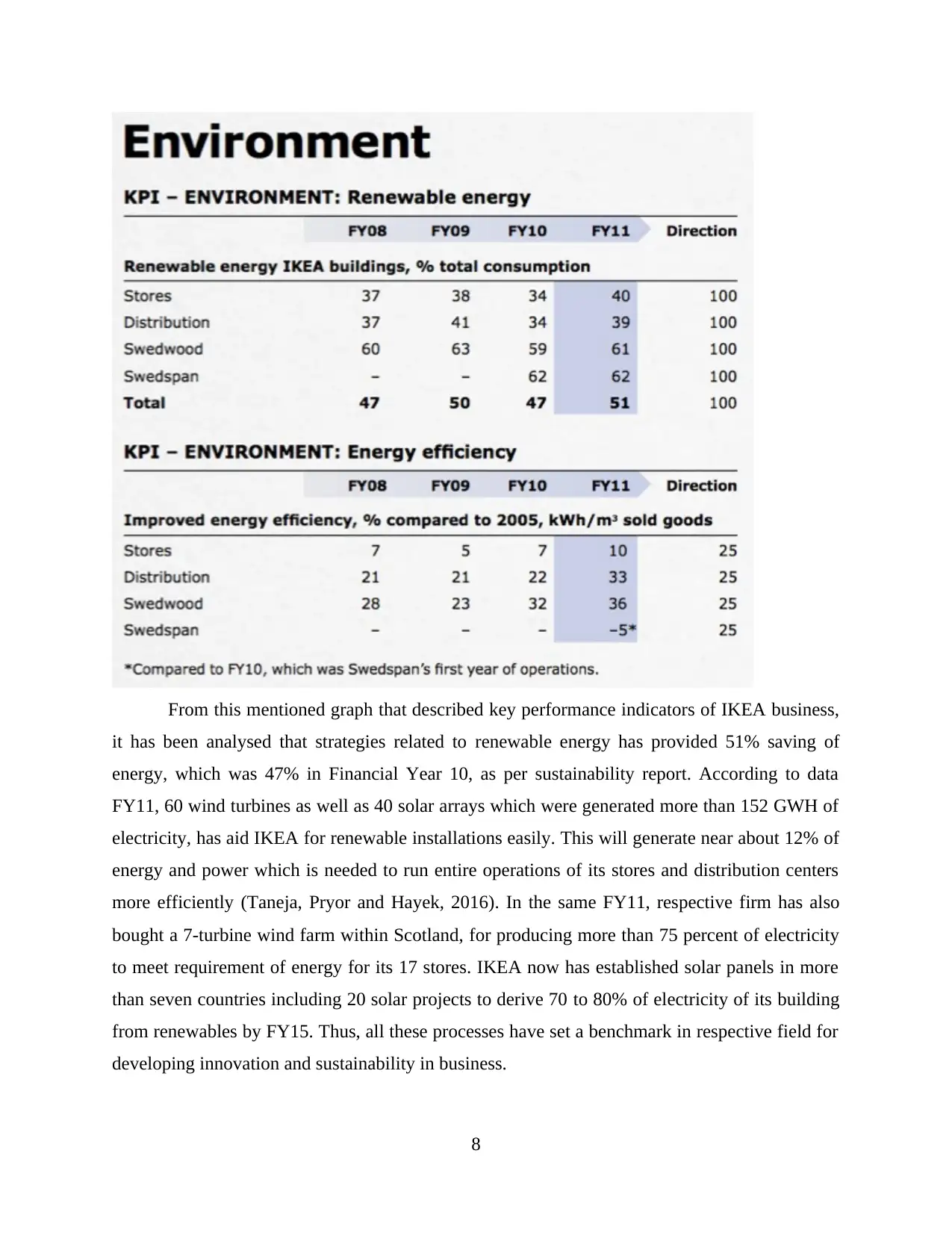
From this mentioned graph that described key performance indicators of IKEA business,
it has been analysed that strategies related to renewable energy has provided 51% saving of
energy, which was 47% in Financial Year 10, as per sustainability report. According to data
FY11, 60 wind turbines as well as 40 solar arrays which were generated more than 152 GWH of
electricity, has aid IKEA for renewable installations easily. This will generate near about 12% of
energy and power which is needed to run entire operations of its stores and distribution centers
more efficiently (Taneja, Pryor and Hayek, 2016). In the same FY11, respective firm has also
bought a 7-turbine wind farm within Scotland, for producing more than 75 percent of electricity
to meet requirement of energy for its 17 stores. IKEA now has established solar panels in more
than seven countries including 20 solar projects to derive 70 to 80% of electricity of its building
from renewables by FY15. Thus, all these processes have set a benchmark in respective field for
developing innovation and sustainability in business.
8
it has been analysed that strategies related to renewable energy has provided 51% saving of
energy, which was 47% in Financial Year 10, as per sustainability report. According to data
FY11, 60 wind turbines as well as 40 solar arrays which were generated more than 152 GWH of
electricity, has aid IKEA for renewable installations easily. This will generate near about 12% of
energy and power which is needed to run entire operations of its stores and distribution centers
more efficiently (Taneja, Pryor and Hayek, 2016). In the same FY11, respective firm has also
bought a 7-turbine wind farm within Scotland, for producing more than 75 percent of electricity
to meet requirement of energy for its 17 stores. IKEA now has established solar panels in more
than seven countries including 20 solar projects to derive 70 to 80% of electricity of its building
from renewables by FY15. Thus, all these processes have set a benchmark in respective field for
developing innovation and sustainability in business.
8
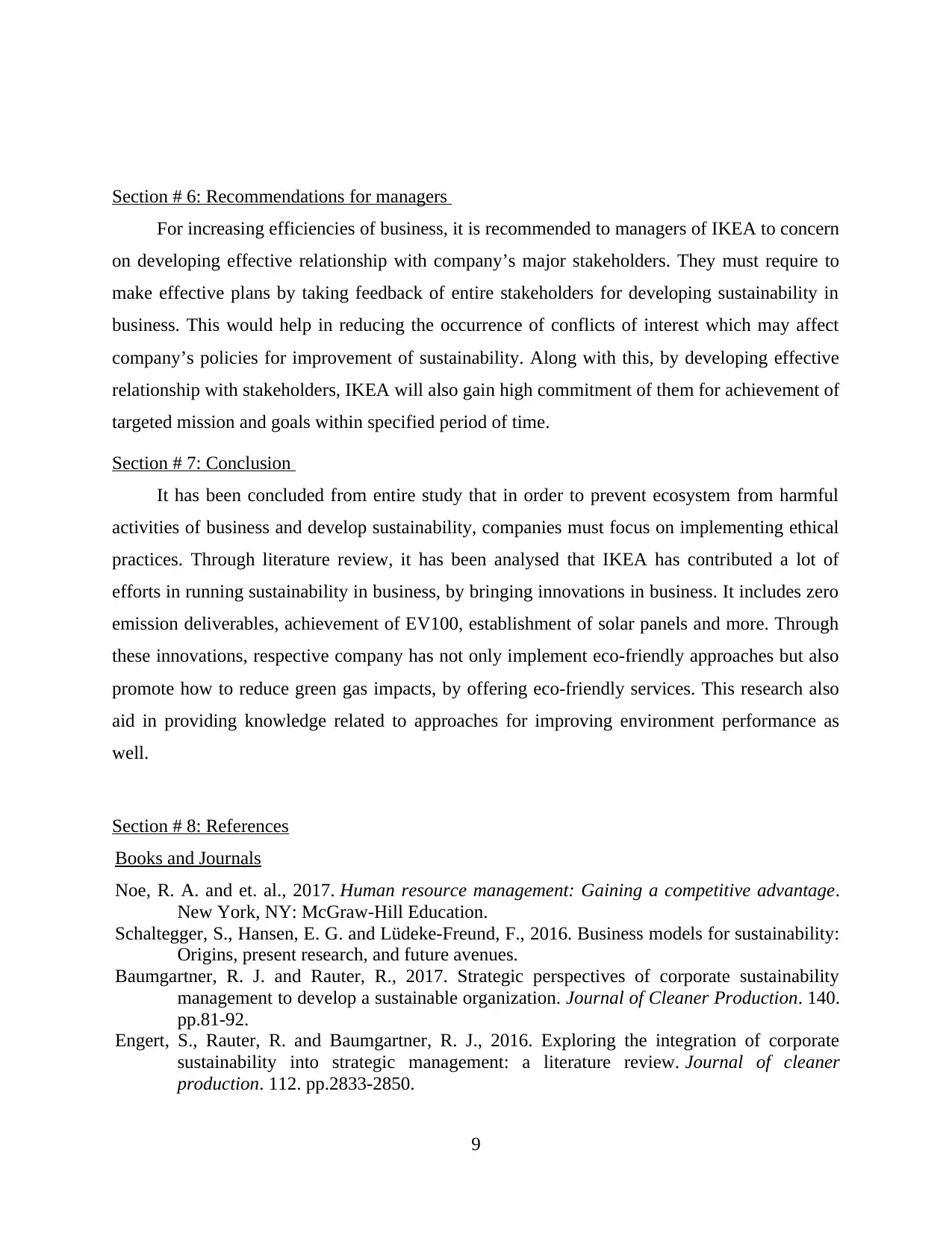
Section # 6: Recommendations for managers
For increasing efficiencies of business, it is recommended to managers of IKEA to concern
on developing effective relationship with company’s major stakeholders. They must require to
make effective plans by taking feedback of entire stakeholders for developing sustainability in
business. This would help in reducing the occurrence of conflicts of interest which may affect
company’s policies for improvement of sustainability. Along with this, by developing effective
relationship with stakeholders, IKEA will also gain high commitment of them for achievement of
targeted mission and goals within specified period of time.
Section # 7: Conclusion
It has been concluded from entire study that in order to prevent ecosystem from harmful
activities of business and develop sustainability, companies must focus on implementing ethical
practices. Through literature review, it has been analysed that IKEA has contributed a lot of
efforts in running sustainability in business, by bringing innovations in business. It includes zero
emission deliverables, achievement of EV100, establishment of solar panels and more. Through
these innovations, respective company has not only implement eco-friendly approaches but also
promote how to reduce green gas impacts, by offering eco-friendly services. This research also
aid in providing knowledge related to approaches for improving environment performance as
well.
Section # 8: References
Books and Journals
Noe, R. A. and et. al., 2017. Human resource management: Gaining a competitive advantage.
New York, NY: McGraw-Hill Education.
Schaltegger, S., Hansen, E. G. and Lüdeke-Freund, F., 2016. Business models for sustainability:
Origins, present research, and future avenues.
Baumgartner, R. J. and Rauter, R., 2017. Strategic perspectives of corporate sustainability
management to develop a sustainable organization. Journal of Cleaner Production. 140.
pp.81-92.
Engert, S., Rauter, R. and Baumgartner, R. J., 2016. Exploring the integration of corporate
sustainability into strategic management: a literature review. Journal of cleaner
production. 112. pp.2833-2850.
9
For increasing efficiencies of business, it is recommended to managers of IKEA to concern
on developing effective relationship with company’s major stakeholders. They must require to
make effective plans by taking feedback of entire stakeholders for developing sustainability in
business. This would help in reducing the occurrence of conflicts of interest which may affect
company’s policies for improvement of sustainability. Along with this, by developing effective
relationship with stakeholders, IKEA will also gain high commitment of them for achievement of
targeted mission and goals within specified period of time.
Section # 7: Conclusion
It has been concluded from entire study that in order to prevent ecosystem from harmful
activities of business and develop sustainability, companies must focus on implementing ethical
practices. Through literature review, it has been analysed that IKEA has contributed a lot of
efforts in running sustainability in business, by bringing innovations in business. It includes zero
emission deliverables, achievement of EV100, establishment of solar panels and more. Through
these innovations, respective company has not only implement eco-friendly approaches but also
promote how to reduce green gas impacts, by offering eco-friendly services. This research also
aid in providing knowledge related to approaches for improving environment performance as
well.
Section # 8: References
Books and Journals
Noe, R. A. and et. al., 2017. Human resource management: Gaining a competitive advantage.
New York, NY: McGraw-Hill Education.
Schaltegger, S., Hansen, E. G. and Lüdeke-Freund, F., 2016. Business models for sustainability:
Origins, present research, and future avenues.
Baumgartner, R. J. and Rauter, R., 2017. Strategic perspectives of corporate sustainability
management to develop a sustainable organization. Journal of Cleaner Production. 140.
pp.81-92.
Engert, S., Rauter, R. and Baumgartner, R. J., 2016. Exploring the integration of corporate
sustainability into strategic management: a literature review. Journal of cleaner
production. 112. pp.2833-2850.
9
⊘ This is a preview!⊘
Do you want full access?
Subscribe today to unlock all pages.

Trusted by 1+ million students worldwide
1 out of 15
Related Documents
Your All-in-One AI-Powered Toolkit for Academic Success.
+13062052269
info@desklib.com
Available 24*7 on WhatsApp / Email
![[object Object]](/_next/static/media/star-bottom.7253800d.svg)
Unlock your academic potential
Copyright © 2020–2025 A2Z Services. All Rights Reserved. Developed and managed by ZUCOL.

![Business Management at Sustainable Level: Report, [University Name]](/_next/image/?url=https%3A%2F%2Fdesklib.com%2Fmedia%2Fimages%2Ftw%2F2e75d5dbe7df46d690932c577a9b4f2c.jpg&w=256&q=75)



